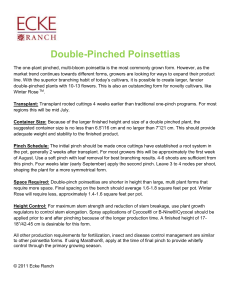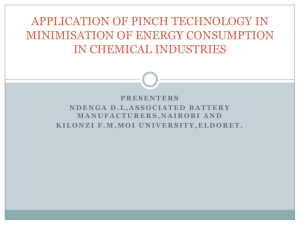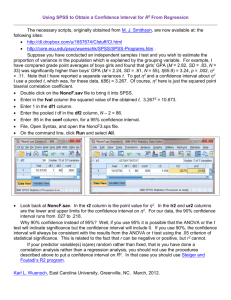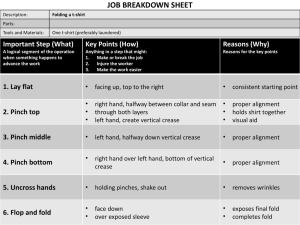Distillation
advertisement
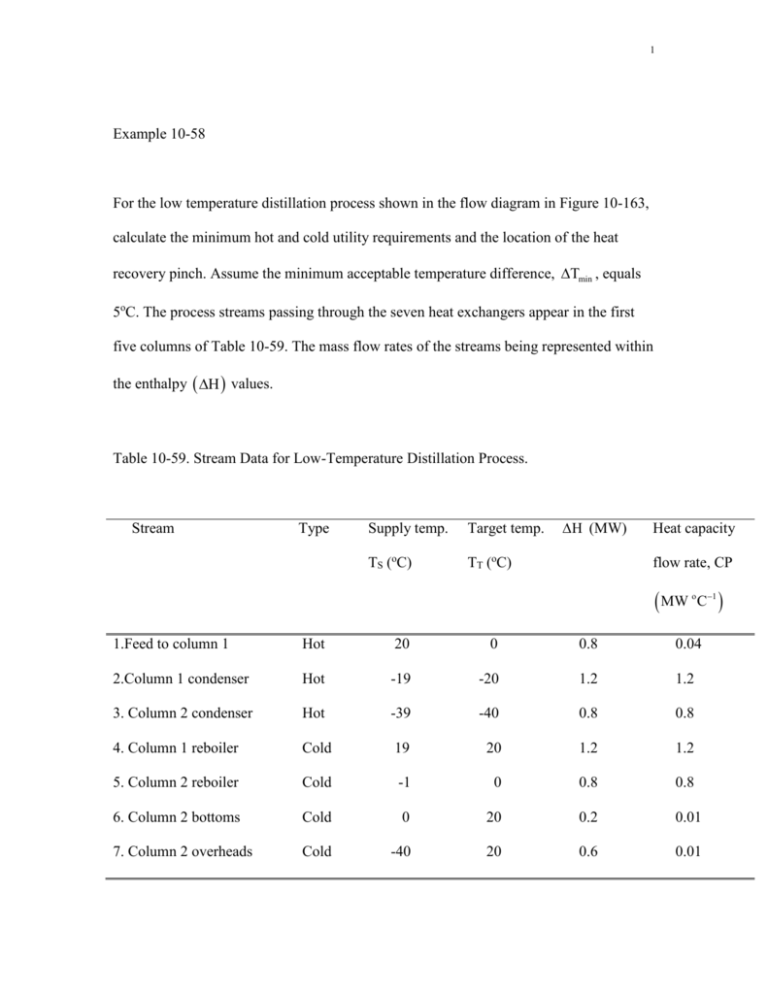
1 Example 10-58 For the low temperature distillation process shown in the flow diagram in Figure 10-163, calculate the minimum hot and cold utility requirements and the location of the heat recovery pinch. Assume the minimum acceptable temperature difference, Tmin , equals 5oC. The process streams passing through the seven heat exchangers appear in the first five columns of Table 10-59. The mass flow rates of the streams being represented within the enthalpy values. Table 10-59. Stream Data for Low-Temperature Distillation Process. Stream Type Supply temp. Target temp. TS (oC) TT (oC) (MW) Heat capacity flow rate, CP MW o C1 1.Feed to column 1 Hot 20 0 0.8 0.04 2.Column 1 condenser Hot -19 -20 1.2 1.2 3. Column 2 condenser Hot -39 -40 0.8 0.8 4. Column 1 reboiler Cold 19 20 1.2 1.2 5. Column 2 reboiler Cold -1 0 0.8 0.8 6. Column 2 bottoms Cold 0 20 0.2 0.01 7. Column 2 overheads Cold -40 20 0.6 0.01 2 Solution Calculation Procedure: 1. For each stream, calculate its heat capacity flow rate. For a given stream, the heat capacity flow rate, CP is defined as divided by the absolute value of the difference between the supply temperature and the target temperature. For example, for Stream 1, the feed to Column 1, CP = 0.8/(20-0) = 0.04 MW/oC. The heat capacity flow rates for the seven streams appear in the last column of Table 10-59. 2. For each stream, modify the supply and target temperatures to assure that the minimum temperature-difference requirement is met. This step consists of lowering the supply and target temperatures of each hot stream by Tmin 2 and raising the supply and target temperatures of each cold stream by Tmin 2 . For stream 1 (a hot stream), for instance, the supply temperature drops from 20 to 17.5oC, and the target temperature drops 0 to -2.5oC, alternatively, stream 4 (a cold stream), the supply temperature increases from 19 to 21.5oC, and the target temperature increases from 20 to 22.5oC. The shifted temperatures for the seven streams are shown in Table 10-60. 3 Table 10-60. Shifted Temperatures for the Data in Table 10-59. Stream Type Supply temp. Target temp. TS (oC) TT (oC) 1 Hot 20 0 2 Hot -19 3 Hot 4 TS* TT* 17.5 -2.5 -20 -21.5 -22.5 -39 -40 -41.5 -42.5 Cold 19 20 21.5 22.5 5 Cold -1 0 1.5 2.5 6 Cold 0 20 2.5 22.5 7 Cold -40 20 -37.5 22.5 3. Carry out a heat balance within each interval between the shifted temperatures. To display the temperature intervals, take all the 14 shifted supply and target temperatures (two for each of the seven streams) and list them in descending order (noting that few temperatures, such as 22.5oC, may appear more than once, and thus are not repeated). The resulting list is shown in Figure 10164. Draw horizontal lines extending leftward through each temperature value on the list. The regions between the lines are the temperature intervals, whose numerical values appear in the third column of Table 10-61. For example, the region between 21.5 and 17.5oC represents a temperature interval of (21.5-17.5) or 4oC. 4 Figure 10-164. Streams and temperature intervals. 22.5 oC--------------------------------------------------------------------------------------------------------------------CP= 1.2 21.5 oC--------------------------------------------------------------------------------------------------------------------4 1 17.5 oC-------------------------------------------------------------------------------------------------------------------CP = 0.01 2.5 oC---------------------------------------------------------------------------------------------------------------------6 CP = 0.04 1.5 oC----------------------------------------------------------------------------------------------------------------------5 CP = 0.01 -2.5 oC---------------------------------------------------------------------------------------------------------------------2 -21.5 oC--------------------------------------------------------------------------------------------------------------------CP = 1.2 CP = 0.01 -22.5 oC---------------------------------------------------------------------------------------------------------------------- -37.5 oC---------------------------------------------------------------------------------------------------------------------7 3 -41.5 oC----------------------------------------------------------------------------------------------------------------------CP = 0.8 -42.5oC------------------------------------------------------------------------------------------------------------------------ Then, represent each of the seven streams by drawing vertical lines, starting at the shifted supply temperature and extending downward (for hot streams being cooled) or upward (for cold streams being heated) until reaching the shifted target temperature. For Stream 1, for instance, the line begins at the line for 17.5 2.5 o o C and extends downwards to - C . Label each line with its CP value (e.g. CP = 0.04 for Stream 1). The resulting seven vertical streams lines as shown in Figure 10-164 are referred to as streams and temperature intervals. For each of the ten temperature intervals, sum the heat capacity flow rates for the hot stream being cooled that falls within the interval, then subtract the sum of the heat capacity flow rate of each cold stream being heated that falls within the interval. The resulting algebraic sums are in the fourth column of Table 10-61. For example, there are three streams within the interval between 17.5 and 2.5 o C , namely Stream 1 being cooled, with CP = 0.04, Stream 6, being heated, with CP = 0.01; and Stream 7, being heated with CP = 0.01. The resulting algebraic sum is (0.04 – 0.01 + 0.01), or 0.02. Finally, multiply each temperature difference in Column 3 by the corresponding algebraic sum of heat capacity flow rates in Column 4. The result is the heat balance, or enthalpy change, , in kilowatts for that interval. The intervals 5 having a positive a negative , such as the interval between 17.5 and 2.5 o C are designated as surplus, and the intervals with are designated as deficit. The results are shown in the fifth and sixth columns of Table 10-61. Table 10-61. Temperature-interval heat balances for Example 10-58. Shift Interval Temperature, o C Ti1 Ti o C mCpnet INTERVAL kW/K kW Surplus/Deficit 22.5 1 1 -1220.0 -1220.0 Deficit 2 4 -20.0 -80.0 Deficit 3 15 20 300.0 Surplus 4 1 -770.0 -770.0 Deficit 5 4 30.0 120.0 Surplus 6 19 -10.0 -190.0 Deficit 7 1 1190.0 1190.0 Surplus 8 15 -10.0 -150.0 Deficit 9 4 0 0.0 ---------- 10 1 800.0 800.0 Surplus 21.5 17.5 2.5 1.5 -2.5 -21.5 -22.5 -37.5 -41.5 -42.5 4. Cascade the surplus and deficit heat down the temperature scale from interval to interval, and note the largest net deficit that results. That number is the minimum hot-utility requirement (Maximum energy recovery). Cascaded heat is the amount of heat the problem has available from the hot streams over that required by the cold streams as we move from the higher temperatures to the lower ones. Anywhere we see a negative value in this 6 cascaded heat column, we know that the hot streams have not produced enough heat to satisfy the needs of the cold streams above this entry. We look for the largest negative value or zero in this column and add this amount of heat Qmin as hot utility to the first interval in the cascade. All the net heat flows in the cascade now increase by this amount, and the minimum value becomes zero. This is the feasible heat cascade, or Problem Table. The heat added to the first interval is the hot utility requirement (target) QH min , and the heat removed from the final interval is the cold utility target QC min . The point(s) at which there is zero net heat flow in the cascade is the pinch. The plot of the net heat flow (horizontal axis) against the shifted temperature (vertical axis) is the Grand composite curve (GCC). Arrange the ∆H values as shown in Table 10-62, with the temperatures taken from the first column of the Table. Assign a positive number if the cumulative value is surplus or a negative value if it is deficit. Starting from a value of 0.0, i.e. assuming no heat is supplied to the hottest interval 1 from hot utility, then the deficit of 1220 kW from interval 1 is cascaded into interval 2. There it joins the 80 kW deficit from interval 2, making a deficit of 1300 kW to cascade into interval 3. Interval 3 has a surplus of 300 kW, hence after accepting the 1300 kW, it can be regarded as passing on a 1000 kW deficit to interval 4. Interval 4 has a 770 kW deficit and so passes on a 1770 kW deficit to interval 5 and so on, until it reaches interval 9 with 0 kW. A deficit of 800 kW leaves interval 9 and is cascaded into interval 10. Finally, the 800 kW surplus in interval 10 means that 0 7 kW is the final cascaded energy to the cold utility. Looking at the heat flows in Table 10-62, some are negative, which is thermodynamically infeasible as heat cannot be transferred up the temperature scale. To make the cascade just feasible, sufficient heat must be added from a hot utility to make the heat flow at least zero. The smallest amount of heat required from a hot utility is the largest negative heat flow from Table 10-62, i.e., 1840 kW. In Table 10-62, 1840 kW is added to the first interval from a hot utility. This does not change the heat balance within each interval but increases all the heat flows between the intervals by 1840 kW, giving one heat flow of just zero at an interval temperature of -21.5oC. To confirm this, repeat the downward cascading but begin with an assumed input of 1840 kW at the top of the cascade, as shown in Table 10-62. Note that, as a result, no deficit results. The top value in the last column of Table 10-62, 1840 kW, is the minimum amount of heat we must put into the problem from hot utilities; the bottom value, 1840 kW, is the minimum amount of heat we must remove from the problem using cold utilities. 5. Find the heat-recovery pinch point. The pinch arises at the point where, after adding the minimum heat utility, the cumulative sum of ∆H values is zero. In this case, it occurs at -21.5oC. Assuming that the heat exchangers become networked appropriately, and keeping in mind that the pinch result of -21.5oC emerges after the temperatures were shifted, in step 2, we note that at the pinch, the hot stream being cooled is a temperature of 21.5 Tmin 2 or (-21.5 + 2.5), or -19oC, and the cold stream being heated is at 21.5 Tmin 2 , or -24oC. 8 Figure 10-165 shows the plot of hot and cold composite curves, i.e. the actual temperature against the heat flow where individual cold streams are combined into a composite cold stream and individual hot streams are combined into a composite hot stream. From Figure 10-165, the minimum heat and cold utility requirements (or maximum energy recovery) at Tmin 5o C can be determined. Figure 10-166 shows the shifted hot and cold composite curves with the pinch temperature of -21.5oC and Figure 10-167 shows the grand composite curve (GCC) of the shifted temperature against the net heat flow respectively. Figure 10-167 represents the difference between the heat available from the hot streams and the required heat by the cold streams, relative to the pinch, at a given shifted temperature. Thus, the GCC is a plot of the net heat flow against the shifted (interval) temperature, which is a graphical plot of the Problem Table (heat cascade) of Tables 10-61 and 10-62. The GCC not only tells us how much net heating and cooling is required, it also tells us what temperatures it is needed at. There is no need to supply all the utility heating at the highest temperature interval; much of it can, if desired, be supplied at lower temperatures. Additionally, the pinch is also easily visualized; being the point where net heat flow is 0 and the GCC touches the axis. As an additional check, the cold utility target minus the hot utility target should equal the bottom value of the infeasible heat cascade, which 0 kW as shown in Table 10-62. Note: In earlier papers, Equation 10-574 i Si Si 1 CPH CPC i (10-574) 9 was reversed; temperature intervals with a net deficit were shown as positive and with a net surplus as negative. However, this is counter-intuitive [351] and more recent practice has been for a heat surplus to be positive. where = heat content S = shifted temperature CPH = heat capacity flow rate of hot fluid. CPC = heat capacity flow rate of cold fluid Since no unit should have a temperature difference smaller than Tmin , a consequence is such that there should be no transfer across the pinch. There are three possible ways of moving the hot and cold composite curves closer together by Tmin so that they touch at the pinch and this may be achieved in three ways. 1. Express all temperatures in terms of hot stream temperature and increase all cold stream temperatures by Tmin . 2. Express all temperatures in terms of cold stream temperatures and reduce all hot stream temperatures by Tmin . 10 3. Use the shifted temperatures, which are a mean value; all hot stream temperatures are reduced by Tmin 2 and all cold stream temperatures are increased by Tmin 2 . The pinch is the point of closest approach between the hot and cold composite curves as shown in Figures 10-165-10-167. It is also the point of zero energy flow in a network with minimum-utility usage. However, since any energy transfer across the pinch increases utility requirements, it is essential that for a minimum-utility design, there can be no energy flow across the pinch. This allows the heat exchanger network (HEN) design to be decomposed into two separate problems, the hot end problem above the pinch and the cold end problem below the pinch. The two problems can be solved separately, and then combined to obtain a solution for the entire network. Due to the low driving force, exchangers operating near the pinch tend to be relatively large and expensive units. Therefore, identification of appropriate stream matches for exchangers operating at the pinch is a key aspect of the process integration methodology. Exchangers that operate at the pinch have a temperature difference equal to Tmin or at least at one end. 11 10-57 The Pinch Design Approach to Inventing a Network In designing a heat exchanger network that uses the minimum utilities for maximum heat recovery, we consider the following steps [352]: 1. Select a Tmin . 2. Calculate the minimum hot and cold utilities use based on this value for Tmin . 3. Using the grand composite curve, pick which utilities to use and their amounts. 4. If the problem has a pinch point in it (which will occur, if step 2 discovers the need for both heating and cooling), divide the problem into two parts at the pinch. We shall design the two parts separately. Remember that the part above the pinch requires only hot utilities, and the part below only cold utilities. 5. Estimate the number of exchangers for each partition as N-1, where N is the number of streams in that part of the problem. 6. Invent a network using all insights available. All exchangers that exit at the pinch point will have the minimum driving force at that point. A small driving force for heat transfer implies a large area. The exchangers near the pinch will tend to be large. Therefore, bad design decisions near the pinch point will tend to be more costly. We should generally make design decisions in the vicinity of the pinch first. 7. Remove heat cycles if possible. 12 For the designer wishing to produce a design in achieving minimum utility targets, the following rules are: No heat transfer between process streams across the Pinch temperature. No external (utility) cooling above the Pinch temperature. No external (utility) heating below the Pinch temperature. Violation of any of the above rules results in higher energy requirements than the theoretical minimum requirements and will adversely affect the energy efficiency. An Excel spreadsheet programs (Example 10-58.xls and Example 10-58a.xls) developed for the book by Ian C. Kemp [351] were used for Example 10-58. The spreadsheet (Example 10-58a.xls) calculates the hot and cold utility requirements for varying dTmin global range between 5oC – 30oC. Figure 10-168 shows the results of hot, cold pinch temperatures and utilities requirements for varying dTmin values, and plots of these parameters for Example 10-58. 13 Table 10-62. Problem Table and Cascade. Shift Temperature, Interval o T(i+1) – Ti o C C CP CP H C o kW C ΔH Infeasible kW Feasible Cascade Cascade From Hot Utility From Hot Utility 22.5 0 1 1 -1.22 -1220 -1220 21.5 1840 -1220 -1220 2 4 -0.02 -80 -80 17.5 620 -80 -1300 3 15 0.02 300 300 2.5 540 300 -1000 4 1 -0.77 -770 -770 1.5 840 -770 -1770 5 4 0.03 120 120 -2.5 70 120 -1650 6 19 -0.01 -190 -21.5 -190 PINCH 7 1 1.19 1190 190 -190 -1840 1190 -22.5 0 1190 -650 8 15 -0.01 -150 -150 -37.5 1190 -150 -800 9 4 0 0 0 -41.5 1040 0 -800 10 1 0.8 800 800 -42.5 1040 800 0 To Cold Utility 1840 To Cold Utility 14 10-59 Appropriate Placement and Integration of Distillation Columns Distillation columns absorb heat at the reboiler temperature and then reject heat at a lower (condenser) temperature. From process integration viewpoint, they operate on temperature and not heat [353]. Thus, columns may be integrated with the background process and/ or with each other to save on utility consumption. Thus, appropriate placement requires positioning a column either entirely above or below the pinch of the background process. If a column is placed above the pinch, then the condenser can reject heat into the process sink; for a column placed below the pinch, then the reboiler can accept heat from the process source. In both of these cases, there is a decrease in the hot and cold utility consumptions. If a column is placed across the pinch, then the reboiler consumes heat from the process sink above the pinch and the condenser rejects heat into the process source below the pinch. The total energy requirements for the column and process together are no different from that for the separate systems. Thus, there are no energy savings from the integration. Additionally, there is a heat load limit for distillation columns which requires that no infeasibility (i.e. negative heat flow) must occur in the cascade for the process over the entire temperatures spanned by the column. For optimum performance, modifications related to reflux ratio, pressure, feed preheating/cooling, side condensers and reboilers may be required. The grand composite curve (GCC) may be used to establish targets in terms of temperature and heat loads for 15 the best combination of these options prior to column/process design. Shenoy [354] and Linnhoff, et. al [353, 355, 356] provide details on column modifications. 10-60 Heat Integration of Distillation Columns - Summary The appropriate placement of distillation columns when carrying out heat integration network is not across the pinch. Further, the grand composite curve as shown in Figure 10-167 can be used as a quantitative tool to assess integration opportunities. The scope for integrating conventional distillation columns into an overall process is restricted, and practical constraints often prevent integration of columns with the rest of the process. If the column cannot be integrated with the rest of the process or the potential for integration is limited by the heat flows elsewhere, then attention must be focused on the distillation operation and complex arrangement being considered. Once the column is integrated, then the driving forces between the composite curves become smaller. This will enable the capital/energy trade-offs of the heat exchanger network to be adjusted accordingly.


